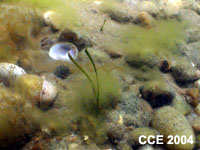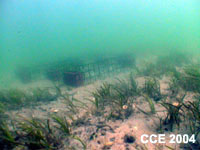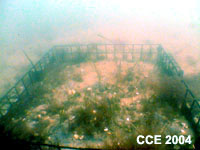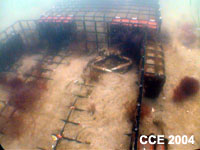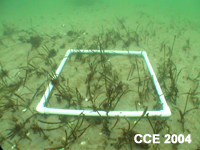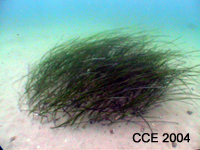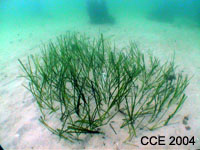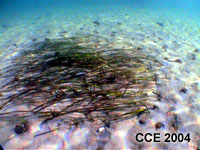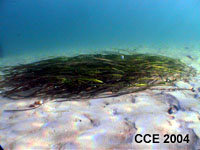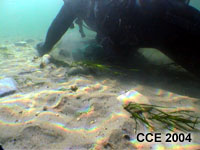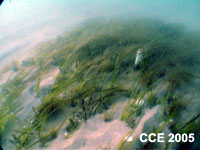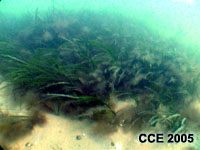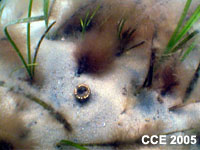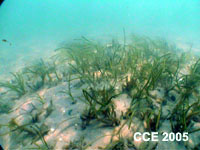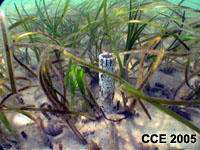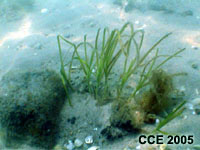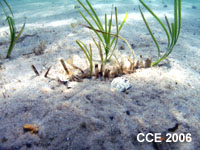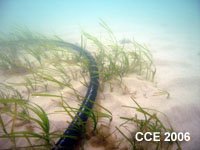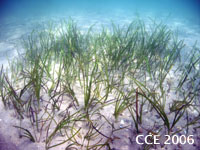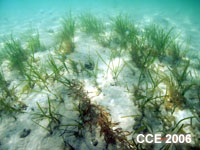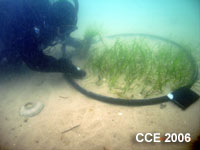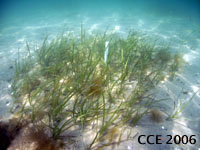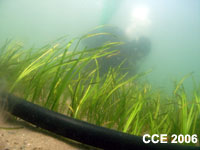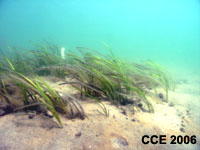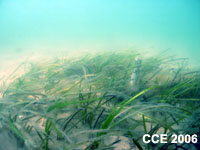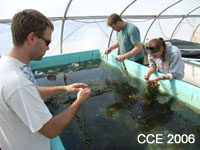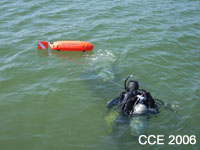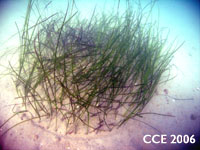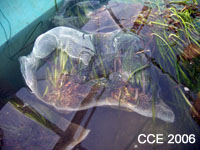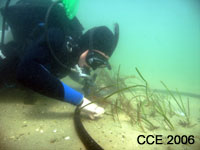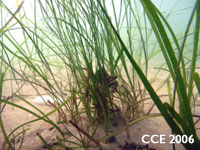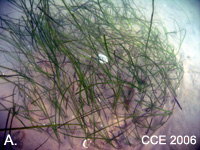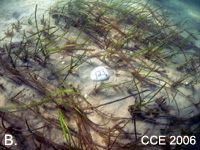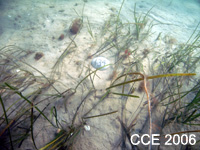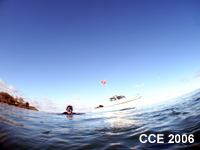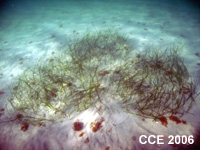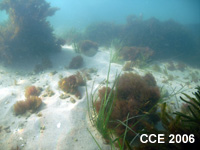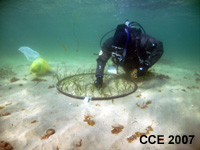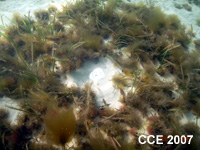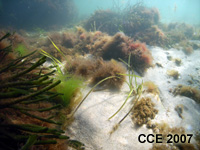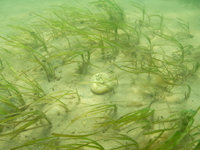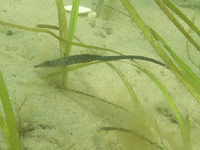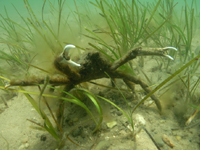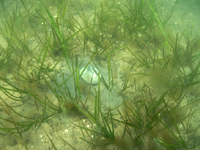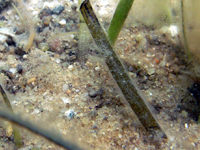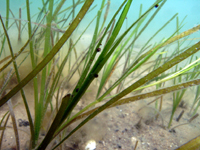Peconic Estuary Eelgrass Restoration Project I
Field Notes
and Observations
Cornelius Pt. Shelter Island, NY
Spring/Summer 2004
May / June 2004 Prior to this date, seed plantings by broadcast
seeding and buoy-deployed seeding (BuDS) were attempted in a shallow,
rocky area, but germination percentages were low. Methods were switched
to TERF systems (Transplanting Eelgrass using Remote Frames) and we
moved into deeper water where there was some existing grass, though
it was very patchy and eroded. Initial TERF plantings took place on
June 24, 2004. A total of 16 TERFS were deployed. |
|
|
|
25May2004-
Seedling from 2003 broadcast seeding. Few seedlings were observed. |
24June2004-
TERF frames were deployed amongst existing patches of eelgrass. |
24June2004- More TERFs just
after deployment. |
July
2004 TERFs were revisited, and some
results proved better than others. It seemed that sediment movement occurred
within many of the frames, and numerous spider crabs were present, burrowing
under the frames. Red algae was very prevalent at this time, probably
drifted in from another location and got caught in/on the TERFs.We also
characterized the existing grass by taking density counts and measuring
the shoot lengths at several stations. This data will be used to define
the restoration protocols for future plantings. |
|
|
|
14July2004- One of the TERFs
that wasn't smothered by sediment and was taking well to transplanting. |
14July2004- Spider crabs
were numerous, taking refuge in the TERFs (and also ripping out transplants). |
16July2004- Notice the sediment
built up in the TERF left hand corner. |
Fall 2004
October 2004 We
experimented with different planting methods including free-planting and
seeding. Eight experimental circle test plots were planted at two different
densities (200/m² and 400/m²), and with two different treatments;
cut blades (to about 6 inches to reduce drag) and uncut blades. A seeding
experiment was also conducted using a 0.25m² quadrat which was seeded
into with 125 seeds in areas of different bottom type (natural grass,
planted grass, and unvegetated bottom). The perimeter as well as the center
of the quadrat was then marked with stakes for relocating the exact area
of seeding before the quadrat was removed. |
|
|
|
29Oct2004- Circle plot just after planting;
this is a 400/m² density with uncut blades. |
29Oct2004- Circle plot at low density
(200/m²) with cut blades. |
29Oct 2004- A previous transplant of
low density grass which was seeded into. |
November
2004 We conducted reconnaissance
dives to observe last months circle test plots and seeding plots. Visibility
was great! Circle plots seemed to be taking well, with the apparent survival
and stability going from 400/m² uncut, 400/m² cut, 200/m² uncut, and 200/m² cut in descending order. Observations
of seeding experiments indicated that considerable erosion occurred, with
some stakes marking seeding areas dislodged or even missing. These observations
suggest that no seedlings are likely to occur in unvegetated areas next
spring. Due to the high sedimentation and erosion that occurs at this
site, seeding doesn't seem to be the best method for planting at this
site, at least until significant vegetation is present. We also conducted
some rock-anchored plantings in deeper water using rocks collected from
the shorefront. The rocks were placed 12-18'' apart into a "grid",
and clumps of shoots were placed under the depression beneath each rock. |
|
|
|
17October2004- Low density
circle plot with cut blades. |
17Oct2004- High density circle
plot with uncut blades. |
17Oct2004- Diver Steve Schott
planting clumps of eelgrass with rock-anchors. |
Spring/Summer 2005
March
/ April 2005 Recon
dives were conducted to observe last fall's plantings. Visibility was
poor and brown algae was prevalent on eelgrass. Circle plots were located,
with some sedimentation that had occurred on the current-facing edges,
but overall the results seemed positive. There didn't appear to be a significant
difference between treatments, though more detailed observations are needed.
Further recon is needed to locate other test plantings. |
|
|
|
7March2005-
A circle plot with some sedimentation on the leading edge. |
8April2005- Another circle
plot, this time with significant sedimentation (notice the stake in the
center is almost fully buried). |
8April2005- A natural patch
with a heavy epiphyte load. |
June 2005 Further observations
of test plantings occurred.
|
|
|
|
1June2005- A high density (400/m²)
uncut plot. |
1June2005- The same high density (400/m²) uncut plot close-up. |
1June2005- A successful rock anchored
planting. |
Spring/Summer 2006
May 2006 The first recon dive of the season was conducted on May 4, 2006. Visibility
was awesome! The circle plots of higher density seemed to be the most
successful, with obvious rhizome expansion, though further analysis is
needed. Rock anchored plantings from Fall 2004 did not survive.On
May 10, we conducted our first planting effort the season as well as did
more recon of old plantings. A total of 7 circle plots at 1m² each
were planted, at a density of 400 shoots/m². All of the transplants
were from Orient Point with the exception of one circle plot, in which
we used plants from a nearby meadow off of Shelter Island. Old plantings
were observed, and a hoop of the original size of 1m² was used to
show the growth and expansion of the rhizomes since November 2004. A total of 6 more circle plots were planted at 400 shoots/m²
on May 25. Recon of plantings from May 10 also took place, and those plantings
looked great except for one that appeared to have crab damage already. |
|
|
|
|
|
|
4May2006-
top:A rhizome extended off of a high density circle plot. bottom:The high
density (400/m²)
cut plot. bottom: |
10May2006-
top:A m² hoop was placed over our old circle plots (planted Nov.
2004) in order to observe rhizome expansion. bottom:Kim Petersen planting
one of the 7 circle plots that day. |
25May2006-
top: One of 6 circle plots planted on this day. bottom: A circle plot
from 10May appeared to have some crab damage on one side.
|
| June 2006 Four more circle plots of 400 shoots/m²
were planted along with some test plots of seedlings grown over the winter
in our eelgrass greenhouse. Earlier plantings from this year were also observed. |
|
|
|
| 13June2006- Steve Schott planting
one of 4 circle plots. |
13June2006- Circle plot from May 10, 2006. |
13June2006- Circle plot from May 25, 2006. |
| July and August 2006 Due to the high water temperatures of the
summer months, planting is not feasible. High water temperatures are associated
with plant stress in eelgrass, so transplants would not be expected to survive
during this time. Observations of old plantings were made and any storm
activity was noted. |
Fall/Winter 2006-2007
September 2006 Planting
was initiated during late September once water temperatures began dropping
below 20C (68°F). During this time, 43 m² circle plots were planted (totaling 9300 shoots);
12 at a density of 300/m²,
26 at 200/m²,
and 5 at 100/m².
Donor plants were largely from Orient Point, though a number came from
Long Beach in Orient and a meadow off of Fisher's Island. The plots are
in a grid format with multiple parallel transects running off shore at
depths of approximately 4-6 feet. Plots are approximately 2 meters apart
from eachother on all sides. Since recent storm activity caused some of
our stakes that labeled our plots to uproot, we now label each plot with
a small, flat, numbered stone to keep track of date planted, who planted
it, and plant density. |
|
|
|
|
|
|
22Sept2006- top: Preparation of eelgrass
shoots in our greenhouse. bottom: Shoots sorted, counted, and ready for
transplant. |
22Sept2006- top: Preparing for plantings,
divers attach shoots to an anchor below water. bottom: Diver Kim Petersen
planting a circle plot. |
22Sept2006- top: A completed circle plot
of 200 shoots/m².
bottom: A spider crab showing its affection towards the newly planted eelgrass. |
|
October 2006 The
month of October was a busy one for us at Cornelius Pt. The total number
of plots planted were 52, each with a density of 200 shoots (totaling 10,400
shoots planted this month!). |
|
|
|
A. Plot #123 when first planted
on September 22, 2006 and B. The same plot (#123) on October 25, about 1
month later. Though some shoots appear to be missing near where the rock
lies, overall most of the plants remain. |
25Oct2006- This plot (#134) was also planted
on September 22, and suffered slightly more damage, likely from crabs. Still
though, most of the shoots remain. |
November 2006 The
month of November continued to be busy for us at Cornelius Point, with
a total of 9000 shoots planted. We switched methods slightly: instead
of spacing each plot 2 meters apart as we have done so far, we combined
three circle plots into "triple plots". 7800 shoots were planted
in this manner, and all circle plots were planted at a density of 200
shoots/m².
1200 shoots were planted amongst the boulders at the point using rock
anchors to hold down groups of shoots. This method is similar to what
we have done at our high-energy sights like St. Thomas Point (Long Island
Sound). Rock-anchored plantings have worked well for us in environments
with high current/ wave action and rocky substrate. The rocks anchor the
shoots long enough for them to take root, even when high wave energy has
caused sand or other fine substrate to move in or be washed out. This
method was attempted at this sight back in November 2004, but in an area
with different substrate and conditions. We are confident this method
will be more successful at this new location at the point. |
|
|
|
9Nov2006- A view from topside as
we work. |
6Nov2006- A triple-plot, each circle
contains 200 shoots.7800 shoots were planted this way. |
9Nov2006- Rock-anchored shoots at
the point, just after being planted. |
January 2007 Due
to the relatively warm temperatures for this time of year, we were able
to extend our field schedule into part of January. We did switch from
wetsuits to dry suits, and were able to get in a few more plantings and
do some reconnaissance work to help sum-up our work for 2006. Four more
circle plots were planted totaling 800 shoots, and many photos of previously
planted circle plots were taken for purposes for our inventory and for
observational analysis later. |
|
|
|
4Jan2007- Steve Schott planting
1 of 4 circle plots. |
4Jan2007- Circle plot #123 planted
in September (See October A. and B.). |
4Jan2007- Rock anchored plantings
at the point. |
Spring/Summer 2007
| May/June 2007 Monitoring of last winter's plantings began on 30May07 |
|
|
|
|
|
|
| 30May07- |
30May07- |
30May07- |
under construction... |

